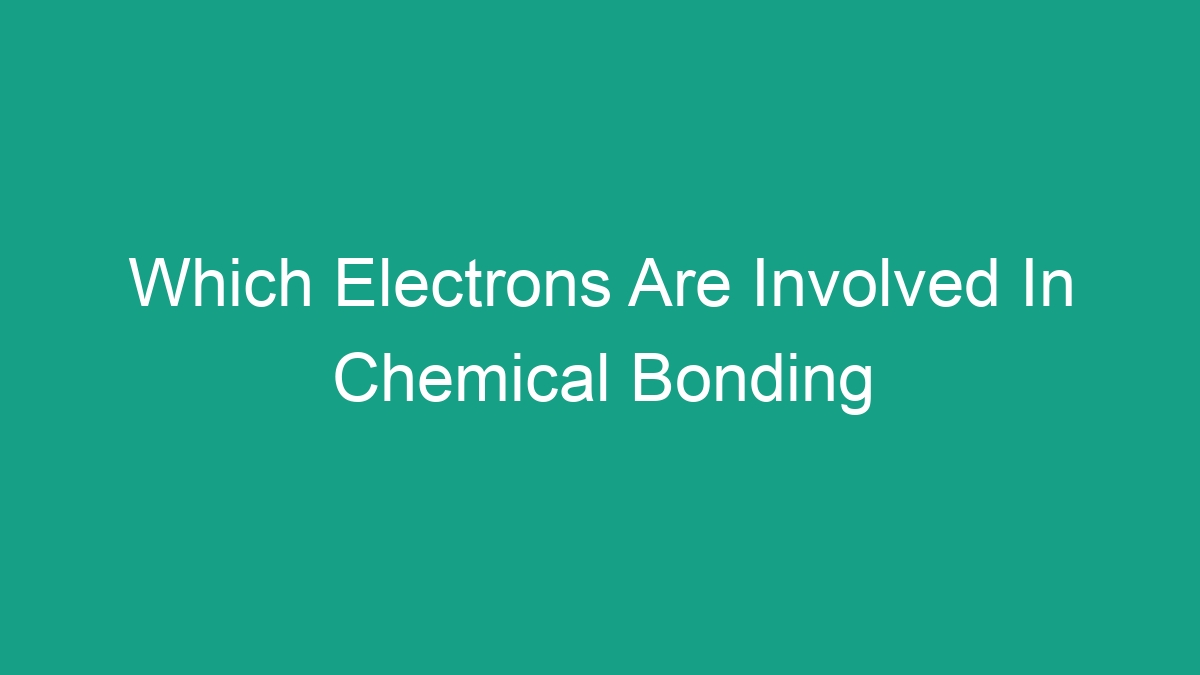
Chemical bonding is a fundamental concept in chemistry, as it explains how atoms come together to form molecules and compounds. Atoms are composed of protons, neutrons, and electrons, and it is the interactions between these particles that lead to the formation of chemical bonds. In this article, we will explore the role of electrons in chemical bonding and discuss which electrons are involved in this crucial process.
The Role of Electrons in Chemical Bonding
Electrons play a central role in chemical bonding due to their negative charge and their ability to move between atoms. It is the interaction between the outermost electrons of different atoms that determines how they will bond with each other. These outermost electrons are referred to as valence electrons and are the ones primarily involved in chemical bonding.
When atoms come into close proximity to each other, their valence electrons interact, leading to the formation of chemical bonds. There are several types of chemical bonds, including ionic bonds, covalent bonds, and metallic bonds, each of which involves the sharing or transfer of electrons between atoms.
Valence Electrons and Chemical Bonding
Valence electrons are the electrons in the outermost energy level of an atom. These electrons are responsible for the chemical behavior of the atom, as they are the ones involved in bonding with other atoms. The number of valence electrons an atom has can be determined by its position on the periodic table. For example, in group 1 elements (such as hydrogen and lithium), there is 1 valence electron, while in group 17 elements (such as fluorine and chlorine), there are 7 valence electrons.
When atoms bond with each other, they do so in order to achieve a stable electron configuration, often by filling their outermost energy level with the maximum number of electrons. This can be achieved through the sharing or transfer of valence electrons, leading to the formation of chemical bonds.
Types of Chemical Bonds and Their Electron Involvement
As mentioned earlier, there are several types of chemical bonds, each of which involves the interaction of electrons in different ways. Let’s take a closer look at each type:
Ionic Bonds
- Ionic bonds form when one atom transfers one or more valence electrons to another atom. This transfer results in the formation of positively charged ions (cations) and negatively charged ions (anions), which are then attracted to each other due to their opposite charges. Ionic bonds are commonly found in compounds composed of metal and nonmetal elements, such as sodium chloride (NaCl).
Covalent Bonds
- Covalent bonds form when atoms share one or more pairs of valence electrons. This sharing allows both atoms to achieve a stable electron configuration, typically by filling their outermost energy level. Covalent bonds are commonly found in molecules composed of nonmetal elements, such as water (H2O) and methane (CH4).
Metallic Bonds
- Metallic bonds occur in metals and involve the delocalized sharing of valence electrons among a network of metal atoms. This sharing leads to the formation of a “sea” of electrons that hold the metal atoms together in a stable structure. Metallic bonds are responsible for the characteristic properties of metals, such as conductivity and malleability.
Electronegativity and Polar Covalent Bonds
Electronegativity is a measure of an atom’s ability to attract and hold onto electrons when participating in a chemical bond. In covalent bonds, the electronegativity difference between the atoms involved can determine the nature of the bond. When the electronegativity difference is significant, the bond is considered polar covalent, meaning that the shared electrons are not equally distributed between the atoms.
In a polar covalent bond, the more electronegative atom attracts the shared electrons more strongly, leading to a partial negative charge on that atom and a partial positive charge on the other. This unequal sharing of electrons creates a separation of charge within the molecule, resulting in a polar molecule. An example of a polar covalent compound is hydrogen fluoride (HF), where the fluorine atom is more electronegative than the hydrogen atom, leading to a partial negative charge on fluorine and a partial positive charge on hydrogen.
Role of Core Electrons in Chemical Bonding
While valence electrons are primarily involved in chemical bonding, core electrons also play a role in determining the stability and reactivity of atoms. Core electrons are the inner electrons of an atom that are not involved in bonding and are found in complete energy levels closer to the nucleus. These electrons shield the valence electrons from the attractive force of the nucleus, thereby influencing the atom’s ability to interact with other atoms.
The number of core electrons also affects the size of the atom and its ability to form bonds. Generally, atoms with more core electrons are larger in size and have a weaker attraction for valence electrons, making them more likely to form bonds with other atoms. Understanding the role of core electrons helps in predicting the behavior of atoms and the types of bonds they can form.
Conclusion
In conclusion, the electrons involved in chemical bonding play a crucial role in determining the properties and behavior of substances. Valence electrons are primarily responsible for the formation of chemical bonds, and their interactions lead to the diverse types of bonds observed in chemistry. Understanding the nature of these electrons and their involvement in bonding is essential for grasping the foundations of chemical reactivity and the creation of new materials.
As we continue to explore the complexities of chemical bonding, it becomes evident that the behavior of electrons is at the heart of understanding the structures and properties of the world around us.



